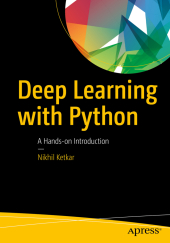 Neuerscheinungen 2017Stand: 2020-02-01 |
Schnellsuche
ISBN/Stichwort/Autor
|
Herderstraße 10
10625 Berlin
Tel.: 030 315 714 16
Fax 030 315 714 14
info@buchspektrum.de |

Nikhil Ketkar
Deep Learning with Python
A Hands-on Introduction
1st ed. 2017. xvii, 226 S. 28 SW-Abb., 65 Farbabb. 254 mm
Verlag/Jahr: SPRINGER, BERLIN; APRESS 2017
ISBN: 1-484-22765-4 (1484227654)
Neue ISBN: 978-1-484-22765-7 (9781484227657)
Preis und Lieferzeit: Bitte klicken
Discover the practical aspects of implementing deep-learning solutions using the rich Python ecosystem. This book bridges the gap between the academic state-of-the-art and the industry state-of-the-practice by introducing you to deep learning frameworks such as Keras, Theano, and Caffe. The practicalities of these frameworks is often acquired by practitioners by reading source code, manuals, and posting questions on community forums, which tends to be a slow and a painful process. Deep Learning with Python allows you to ramp up to such practical know-how in a short period of time and focus more on the domain, models, and algorithms.
This book briefly covers the mathematical prerequisites and fundamentals of deep learning, making this book a good starting point for software developers who want to get started in deep learning. A brief survey of deep learning architectures is also included.
Deep Learning with Python also introduces you to key concepts of automatic differentiation and GPU computation which, while not central to deep learning, are critical when it comes to conducting large scale experiments.
What You Will Learn
Leverage deep learning frameworks in Python namely, Keras, Theano, and Caffe
Gain the fundamentals of deep learning with mathematical prerequisites
Discover the practical considerations of large scale experiments
Take deep learning models to production
Who This Book Is For
Software developers who want to try out deep learning as a practical solution to a particular problem. Software developers in a data science team who want to take deep learning models developed by data scientists to production.
Chapter 1: An intuitive look at the fundamentals of deep learning based on practical applications Chapter 2: A survey of the current state-of-the-art implementations of libraries, tools and packages for deep learning and the case for the Python ecosystem Chapter 3: A detailed look at Keras [1], which is a high level framework for deep learning suitable for beginners to understand and experiment with deep learning Chapter 4: A detailed look at Theano [2], which is a low level framework for implementing architectures and algorithms in deep learning from scratch Chapter 5: A detailed look at Caffe [3], which is highly optimized framework for implementing some of the most popular deep learning architectures (mainly computer vision) Chapter 6: A brief introduction to GPUs and why they are a game changer for Deep Learning Chapter 7: A brief introduction to Automatic Differentiation Chapter 8: A brief introduction to Backpropagation and Stochastic Gradient Descent Chapter 9: A survey of Deep Learning Architectures Chapter 10: Advice on running large scale experiments in deep learning and taking models to production Chapter 11: Introduction to Tensorflow Chapter 12: Introduction to PyTorch Chapter 13: Regularization Techniques Chapter 14: Training Deep Leaning Models
Nikhil S. Ketkar currently leads the Machine Learning Platform team at Flipkart, India´s largest e-commerce company. He received his Ph.D. from Washington State University. Following that he conducted postdoctoral research at University of North Carolina at Charlotte, which was followed by a brief stint in high frequency trading at Transmaket in Chicago. More recently he led the data mining team in Guavus, a startup doing big data analytics in the telecom domain and Indix, a startup doing data science in the e-commerce domain. His research interests include machine learning and graph theory.


